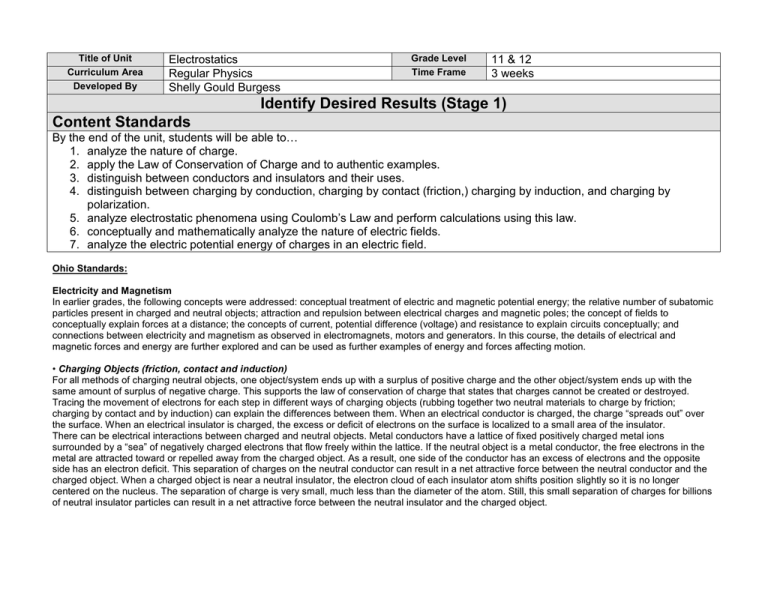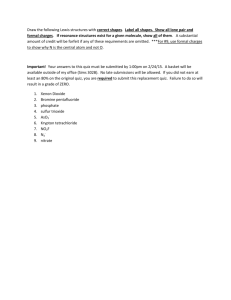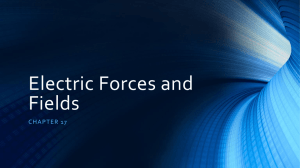Electrostatics – Unit Overview
advertisement

Title of Unit Curriculum Area Developed By Electrostatics Regular Physics Shelly Gould Burgess Grade Level Time Frame 11 & 12 3 weeks Identify Desired Results (Stage 1) Content Standards By the end of the unit, students will be able to… 1. analyze the nature of charge. 2. apply the Law of Conservation of Charge and to authentic examples. 3. distinguish between conductors and insulators and their uses. 4. distinguish between charging by conduction, charging by contact (friction,) charging by induction, and charging by polarization. 5. analyze electrostatic phenomena using Coulomb’s Law and perform calculations using this law. 6. conceptually and mathematically analyze the nature of electric fields. 7. analyze the electric potential energy of charges in an electric field. Ohio Standards: Electricity and Magnetism In earlier grades, the following concepts were addressed: conceptual treatment of electric and magnetic potential energy; the relative number of subatomic particles present in charged and neutral objects; attraction and repulsion between electrical charges and magnetic poles; the concept of fields to conceptually explain forces at a distance; the concepts of current, potential difference (voltage) and resistance to explain circuits conceptually; and connections between electricity and magnetism as observed in electromagnets, motors and generators. In this course, the details of electrical and magnetic forces and energy are further explored and can be used as further examples of energy and forces affecting motion. • Charging Objects (friction, contact and induction) For all methods of charging neutral objects, one object/system ends up with a surplus of positive charge and the other object/system ends up with the same amount of surplus of negative charge. This supports the law of conservation of charge that states that charges cannot be created or destroyed. Tracing the movement of electrons for each step in different ways of charging objects (rubbing together two neutral materials to charge by friction; charging by contact and by induction) can explain the differences between them. When an electrical conductor is charged, the charge “spreads out” over the surface. When an electrical insulator is charged, the excess or deficit of electrons on the surface is localized to a small area of the insulator. There can be electrical interactions between charged and neutral objects. Metal conductors have a lattice of fixed positively charged metal ions surrounded by a “sea” of negatively charged electrons that flow freely within the lattice. If the neutral object is a metal conductor, the free electrons in the metal are attracted toward or repelled away from the charged object. As a result, one side of the conductor has an excess of electrons and the opposite side has an electron deficit. This separation of charges on the neutral conductor can result in a net attractive force between the neutral conductor and the charged object. When a charged object is near a neutral insulator, the electron cloud of each insulator atom shifts position slightly so it is no longer centered on the nucleus. The separation of charge is very small, much less than the diameter of the atom. Still, this small separation of charges for billions of neutral insulator particles can result in a net attractive force between the neutral insulator and the charged object. Coulomb’s law Two charged objects, which are small compared to the distance between them, can be modeled as point charges. The forces between point charges are proportional to the product of the charges and inversely proportional to the square of the distance between the point charges [Fe = ke q1 q2) / r2]. Problems may be solved for the electric force, the amount of charge on one of the two objects or the distance between the two objects. Problems also may be solved for three- or four-point charges in a line if the vector sum of the forces is zero. This can be explored experimentally through computer simulations. Electric forces acting within and between atoms are vastly stronger than the gravitational forces acting between the atoms. However, gravitational forces are only attractive and can accumulate in massive objects to produce a large and noticeable effect whereas electric forces are both attractive and repulsive and tend to cancel each other out. • Electric Fields and Electric Potential Energy The strength of the electrical field of a charged object at a certain location is given by the electric force per unit charge experienced by another charged object placed at that location, E = Fe / q. This equation can be used to calculate the electric field strength, the electric force or the electric charge. However, the electric field is always there, even if the object is not interacting with anything else. The direction of the electric field at a certain location is parallel to the direction of the electrical force on a positively charged object at that location. The electric field caused by a collection of charges is equal to the vector sum of the electric fields caused by the individual charges (superposition of charge). This topic can be explored experimentally through computer simulations. Greater electric field strengths result in larger electric forces on electrically charged objects placed in the field. Electric fields can be represented by field diagrams obtained by plotting field arrows at a series of locations. Electric field diagrams for a dipole, two-point charges (both positive, both negative, one positive and one negative) and parallel capacitor plates are included. Field line diagrams are excluded from this course. The concept of electric potential energy can be understood from the perspective of an electric field. When two attracting or repelling charges interact, the kinetic energies of both objects change but neither is acting as the energy source or the receiver. Instead, the energy is transferred into or out of the electric field around the system as electric potential energy. A single charge does not have electric potential energy. Only the system of attracting or repelling charges can have electric potential energy. When the distance between the attracting or repelling charges changes, there is a change in the electric potential energy of the system. When two opposite charges are moved farther apart or two like charges are moved close together, energy is transferred into the field as electric potential energy. When two opposite charges are moved closer together or two like charges are moved far apart, electric potential energy is transferred out of the field. When a charge is transferred from one object to another, work is required to separate the positive and negative charges. If there is no change in kinetic energy and no energy is transferred out of the system, the work increases the electric potential energy of the system. Understandings Essential Questions Overarching Understanding Students will understand the nature charge and electrostatics. Overarching What is the nature of charge? How do objects become charged? Topical Related Misconceptions Misunderstandings of the structure of atoms and ions A test charge is a real charge. What is Coulomb’s Law? What is the nature of an electric field? What is electric potential energy? What are practical applications of electric potential? Knowledge Skills Students will know… Students will be able to… what gives an object charge. the Law of Charges. the Law of Conservation of Charge. how conductors become charged. how insulators become charged. what an electric field is. what a test charge is. what gives a charged object electric potential energy. What gives an object electric charge? What is the Law of Charges? How does it apply to electrostatics? What is the Law of Conservation of Charge? How does it apply to electrostatics? How do conductors and insulators compare? How do they contrast? By what methods can conductors become charged? By what methods can insulators become charged? How do charge and distance affect the electric force between charges? What is an electric field? How do we represent electric fields using penand-paper models (diagrams?) What is a test charge? How do electric fields of various shapes affect test charges? How do charge, electric field and distance affect the electric potential energy of a charged particle or object? How does movement of a charge in a field affect its electric potential energy? How do batteries create electric potential? How do capacitors create electric potential? How do generators create electric potential? analyze an object’s charge. distinguish between conductors and insulators. determine how a conductor can become charged/how an insulator can become charged. perform calculations using Coulomb’s Law. perform calculations to assess electric fields. determine the effect of electric fields on test charges. perform calculations to assess electric potential energy. Lesson 1 I. Objectives: Students will be able to… 1. analyze the nature of charge. 2. apply the Law of Conservation of Charge and to authentic examples. 3. distinguish between conductors and insulators and their uses. 4. distinguish between charging by conduction, charging by contact (friction,) charging by induction, and charging by polarization. II. Materials: Classroom set of computers with ActivInspire Scotch tape wool & silk plastic rods & glass rods coffee can electroscopes protractors balloons string salt & pepper III. Procedure: A. Hook: Van de Graff generator demonstrations (brief – will revisit later) B. Students take notes on podcast 1 followed by a quiz. C. Debrief podcast 1 using ABC grouping to break content into small bites. D. Jigsaw: Methods of charging followed by jigsaw quiz and debrief E. Students take notes on podcast 2 F. Use materials to demonstrate methods of charging. IV. Evaluation: Podcast quiz, self-assessments, jigsaw quiz, assignment 1, formal quiz Lesson 2 I. Objectives: Students will be able to… 5. analyze electrostatic phenomena using Coulomb’s Law and perform calculations using this law. II. Materials: Classroom set of computers with ActivInspire III. Procedure: A. Students take notes on podcast 3 followed by a quiz. B. Debrief podcast 3 using pair-check and ActivExpressions for conceptual and mathematical practice. IV. Evaluation: Podcast quiz, self-assessments, ActivExpression data, assignment 2, formal quiz Lesson 3 I. Objectives: Students will be able to… 6. conceptually and mathematically analyze the nature of electric fields. II. Materials: Classroom set of computers with ActivInspire Materials for lab Van de Graff generator with demo materials III. Procedure: A. Students take notes on podcast 3 followed by a quiz. B. Debrief podcasts 4 & 5 using pair-check and ActivExpressions for conceptual and mathematical practice. C. Electric fields lab IV. Evaluation: Podcast quiz, self-assessments, ActivExpression data, assignment 5, performance on lab report, formal quiz Lesson 4 I. Objectives: Students will be able to… 7. analyze the electric potential energy of charges in an electric field. II. Materials: Leyden jars, Van de Graff generator, manual generator and capacitors for demos III. Procedure: A. Students take notes on podcasts 6 & 7 followed by a quiz. B. Debrief podcasts 4 & 5 using ABC grouping to break content into small bites. C. Demos with materials IV. Evaluation: Podcast quiz, self-assessments, assignment 4, formal quiz



